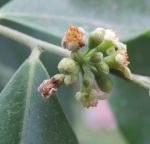 Also known as agarwood, this large evergreen tree is native to Northeast India, Bangladesh, Bhutan and parts of Southeast where it grows as an undercanopy tree mainly in the plains but also on hillsides and rideges, and by rivers and streams. It is a member the Thymelaeaceae family that also includes Daphne. The trees have a straight fluted stem and grow up to 160′ tall but are usually about 6o’. The glossy leaves are 2-3.5″ long leaves and linear-lanceolate to ovate-oblong. Small, inconspicuous, greenish yellow flowers appear on shortly peduncled umbels on the younger branches. The fruits are yellowish capsules. The tree is highly valued for a variety of uses especialy its aromatice resin which is used in perfumery. Other uses include as incense, medicine, paper, and flavoring for curry. Heavy exploitation has led to to the fear that the tree could become extinct. The genus name, Aquilaria, comes from the Latin word aquila, meaning eagle. The specific epithet, agallocha, comes from a Latinized form of an ancient word meaning resinous.
Also known as agarwood, this large evergreen tree is native to Northeast India, Bangladesh, Bhutan and parts of Southeast where it grows as an undercanopy tree mainly in the plains but also on hillsides and rideges, and by rivers and streams. It is a member the Thymelaeaceae family that also includes Daphne. The trees have a straight fluted stem and grow up to 160′ tall but are usually about 6o’. The glossy leaves are 2-3.5″ long leaves and linear-lanceolate to ovate-oblong. Small, inconspicuous, greenish yellow flowers appear on shortly peduncled umbels on the younger branches. The fruits are yellowish capsules. The tree is highly valued for a variety of uses especialy its aromatice resin which is used in perfumery. Other uses include as incense, medicine, paper, and flavoring for curry. Heavy exploitation has led to to the fear that the tree could become extinct. The genus name, Aquilaria, comes from the Latin word aquila, meaning eagle. The specific epithet, agallocha, comes from a Latinized form of an ancient word meaning resinous.
Type: Tropical evergreen tree
Outstanding Feature: Resinous wood
Form: Oval
Growth Rate: Slow
Bloom: Umbels of inconspicuous yellow green flowers
Size: 66-160′ H
Light: Full sun
Soil: Average, moist soil with high rainfall and humidity
Hardiness: Zones 12-13
Care: Low maintenance
Pests and Diseases: Cytosphaera mangiferae, boring insects
Propagation: Seed (viable for only about a month)
Outstanding Selections: Not available
Photo Credit: Wikipedia